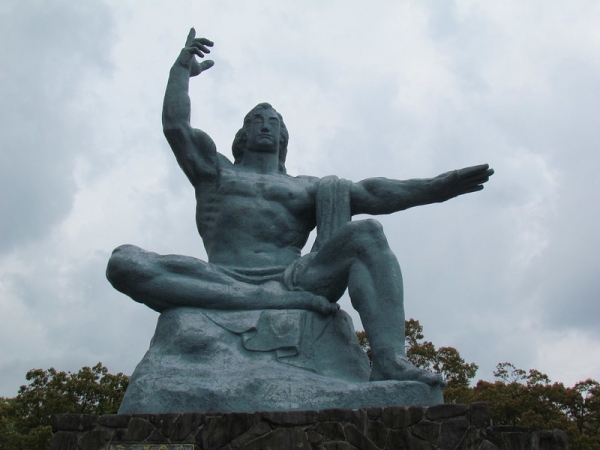A Nagasaki adventure: from befriending animals to exploring an abandoned island

It’s safe to say that the best trips are the ones that stay with you, long after you’ve gone home. I’ve certainly had my fair share of those, like taking a dip in an outdoor onsen while snowflakes melt into the water, or seeing the glittering lights of the city laid out before you as you stand atop a mountain. These are amazing experiences I’d seek out again and again, but what I love even more is an experience that makes you say “I can’t believe that actually happened”. Nagasaki Prefecture (長崎県 Nagasaki-ken) gave me experiences like that and more.
Prior to visiting Nagasaki, I knew a couple of things—1) it was a historically-important port of trade during the Edo Period, and 2) it was the site where the second atomic bomb was dropped during World War II. I had also seen photos of adorable capybaras soaking in onsen from someplace called Nagasaki Bio Park (長崎バイオパーク), and to me, that made a perfect trip. I could visit the museums to soak up all the history, and pet some animals too, but as it turns out, Nagasaki had a lot more in store.
Lively Nagasaki: Nagasaki Bio Park
A capybara really knows how to relax. (Image credit: Winnie Tan)
Japan’s a big fan of the capybara, a giant rodent from South America that is arguably one of the most well-treated animals in Japan. In Nagasaki Bio Park, I was happily surrounded by these cute creatures! They take soaks in natural hot springs, bobbing along with yuzu fruit, and heaters are placed around the enclosure so they don’t get cold. How luxurious, how adorable.
Mara: Excuse me miss, do you want to sign up for a credit card? (Image credit: Winnie Tan)
What sets Nagasaki Bio Park apart from other zoos and other similar establishments is how open the spaces are, allowing visitors a lot of freedom to get up close and personal with the residents (safely, of course). I mingled with the mara, which kind of look like baby kangaroos but are in fact, rodents who are all too happy to beg for snacks. I even fed some flamingos on my way to visit the capybaras, and that’s really just scratching the surface.
It hurt just a little bit. (Image credit: Winnie Tan)
A visit there is guaranteed to give you the warm and fuzzies, and I had the best experience I’ve ever had with animals. You could feed some of them, and an animal caretaker is always around to offer helpful facts about the creatures. It was also here that I got the closest I ever have to a monkey—it hopped onto my shoulder and gave me a solid nip on the ear.
Getting bitten on the ear by a monkey wasn’t a life experience I ever thought I needed, but certainly made my trip all the more interesting. So my final verdict? If you love animals, the park is definitely going to be an amazing place to visit. I for one, am itching to go again.
Nagasaki Bio Park 長崎バイオパーク
Address: Seihi Sakai Nagasaki 851-3302
Nearest station: Huis Ten Bosch Station (ハウステンボス駅) (Free shuttle bus to park available)
Opening hours: 10am–5pm (Last entry 4pm)
Admission fee: ¥1,700 (Adults), ¥800 (Children)
TEL: +81 959-27-1090
Historical Nagasaki: Dejima, Nagasaki Atomic Bomb Museum

View of Dejima. (Image credit: Tzuhsun Hsu / CC BY-SA 2.0)
It would be a shame to visit Nagasaki without also spending some time to understand its history, and there were two sites that are particularly interesting.
Dejima
During the Edo-period, Nagasaki was one of Japan’s earliest ports. The city welcomed traders from far and wide, and Dejima (出島) was a place people would congregate. In its heyday, Dejima was a trading post for the Portuguese and the Dutch, laid out as an island in the shape of a folding fan, lined with buildings in the traditional Japanese style. The island hasn’t existed in its original form in a long time, and in fact, it isn’t even an island anymore. However, the buildings we see today are carefully restored or reconstructed, and each of them house museums and other interesting exhibits that document the history of the area.
Dejima (出島)
Address: 6-1 Dejima-machi, Nagasaki-shi, Nagasaki
Nearest station: Dejima Station (出島駅)
Opening hours: 8am–9pm (Last entry at 8:40pm)
Admission fee: ¥520 (Adults), ¥100 (Children)
TEL: +81-95-821-7200
Nagasaki Atomic Bomb Museum

Full-size replicas of the atomic bombs at the Nagasaki Atomic Bomb Museum (Image credit: John Crowley / CC BY-SA 2.0)
In the final days of World War II, two atomic bombs were dropped on Japan, the first on the city of Hiroshima, and the second on Nagasaki. Looking at Nagasaki City (長崎市 Nagasaki-shi) today, it can be hard to picture the utter destruction that took place, but that does not mean it should be forgotten. The Nagasaki Atomic Bomb Museum is a memorial of an event that changed the lives of many, and documents the aftermath of a city decimated. Some exhibits are truly chilling, showing the damage the bomb has done to people, serving as a reminder of events that should never be repeated.
Nagasaki Atomic Bomb Museum (長崎原爆資料館)
Address: 7-8 Hiranomachi, Nagasaki-shi, Nagasaki
Nearest station: Atomic Bomb Museum tram stop (原爆資料館)
Opening hours: September–April: 8:30am–5:30pm (Last entry 5pm)
May–August: 8:30am–6:30pm (Last entry 6pm)
Admission fee: ¥200 (Adults), ¥100 (Children)
TEL: +81-95-844-1231
Unconventional Nagasaki: Gunkanjima (Hashima Island)
Buildings amidst the rubble (Image credit: Winnie Tan)
Gunkanjima (軍艦島 Battleship Island) appears shrouded in mystery. A man-made island that from far away looks like a battleship, Gunkanjima is located off the coast of Nagasaki, and has a population of zero. The island is completely and utterly abandoned.
A relic of a bygone era, the island was built atop undersea coal mines for the express purpose of mining, and housed some 5,000 people at its peak. As resources began to dwindle in the 1970s, so did the population. Left to fend for itself against harsh elements, the island today lies in complete ruins.
Storm clouds loom over Gunkanjima (Image credit: Winnie Tan)
Boat tours are offered to tourists who are interested in visiting, complete with a local guide. Unaccompanied visits aren’t allowed, so if you do decide to go, joining one of these tours is a must. There are special walkways built along parts of the island and for obvious safety reasons, visitors aren’t permitted to roam.
Visiting an abandoned island is as eerie as you would expect. It’s impossible not to experience some complex feelings about an island once inhabited, but is now seemingly suspended in time while the rest of the world moves forward. Looking at it in this state, it’s hard to believe that many who lived there probably didn’t have to leave the island at all—there was a school for the children, shops, a swimming pool, a hospital, and even a pachinko parlour.
Gunkanjima experiences some harsh weather and choppy waters, so depending on weather conditions, tours may be cancelled. While the tour I went on made it to the island, it was cut short due to looming storm clouds. Gunkanjima cannot be more different from the brightly lit and beautiful tourist spots that are abundant in Japan, but the decades-untouched desolation still seems to have an undeniable draw.
Gunkanjima (軍艦島)
Address: Takashimamachi, Nagasaki, 851-1315
Nearest station: Ohato Station (大波止駅) (From Ohato Station, walk towards the Nagasakiminato Ferry Terminal.)
Note: It is mandatory to join a tour to gain access to Gunkanjima. Please inquire with the local tour company of your choice.
I went to Nagasaki Prefecture as a curious tourist, and what I brought back home with me were utterly unforgettable experiences, and a deep appreciation for a place so multifaceted and vibrant. Even after the adventures I’ve had, I don’t think I’ve seen all the faces of Nagasaki yet. There’s still so much left to discover, and I can’t wait to go again.
Header image credit: IMBiblio / CC BY-SA 2.0





